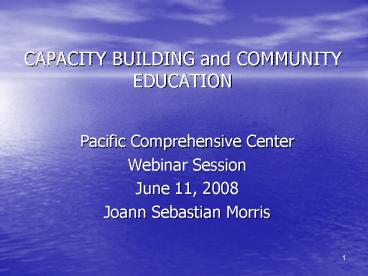CAPACITY BUILDING and COMMUNITY EDUCATION PowerPoint PPT Presentation
1 / 13
Title: CAPACITY BUILDING and COMMUNITY EDUCATION
1
CAPACITY BUILDING and COMMUNITY EDUCATION
- Pacific Comprehensive Center
- Webinar Session
- June 11, 2008
- Joann Sebastian Morris
2
BACKGROUND
- The No Child Left Behind (NCLB) Act urges
increased parental/stakeholder participation in
educational planning, assessment and
accountability. - How do we expand community-wide involvement in
ways that match the diverse Pacific cultures,
traditions, attitudes and behaviors?
3
CURRENT and FUTURE MODELS
- New models for parental involvement across the
Pacific have been developed and are showing
positive results, such as the RMI Cluster PTA
model shared by Evelyn Joseph in this webinar. - We lack similar models for engaging the general
public in education. - Traditional communication systems often limit
communication among certain social classes and
between genders.
4
- Contemporary communication systems may allow
greater flexibility but also limit full
expression by all parties, e.g. job titles may
restrict all but a Secretary or Director from
speaking. - Education systems operate within tradition-rich,
politically charged social systems. How do we
navigate within such systems?
5
WEBINAR TASK
- Lets consider the issue of youth suicide in the
Pacific as a dramatic example of a longstanding
concern, and discuss ways to engage Pacific
educators and communities to reduce the number of
suicide attempts.
6
Our Challenge Shielding Students from Issues
that Trigger a Suicide Attempt
- Each year we read of more youths who attempt or
succeed in a suicide. The numbers are alarming. - The causes usually cited are conflict within the
family, the breakdown of the extended family,
lack of self-esteem, substance abuse, and
romanticizing of suicide.
7
WHOS TALKING ABOUT SUICIDE?
- Education systems know each student but alone
cannot prevent youth suicides. - How do we engage traditional leaders, extended
family members, K-12 and college educators
counselors, PTAs, legislators, business owners,
church officials, NGOs, and young people
themselves in this frightening, vital, social and
education issue?
8
WHO ELSE CAN WE INVOLVE?
- Are there other natural, non-titled leaders in
the community? - Are there male and female elders who could talk
with youths when a problem arises? - How can community organizations NGOs work more
actively with the youth? - How can parent groups strengthen family members
ability to address family tensions
constructively?
9
PUBLIC WILL ESSENTIAL TO SUCCESS
- How do we heighten public awareness of the need
to strengthen youth and families, and not shy
away from the topic of youth suicide? - The film, Morning Comes Too Soon, was recently
completed in the RMI with teens addressing the
suicide issue. It will inform a film festival
audience in Hawaii in July 2008. - To ensure similar action to improve public
awareness is taken NOW, community involvement,
public will, and political will are essential.
10
COMMUNITY OUTREACH
- What forms of communication exist?
- Newspapers
- Radio Television
- Posters, publicly posted
- Church announcements
- Mic. Sem-like reports/documents
- Films
11
GOAL PUBLIC CAPACITY BUILDING
- Any new initiative needs full public sector
involvement for it to take hold and be
successful. - Involving as many stakeholders as possible in the
initiative inevitably leads to discussion,
debate, culturally appropriate action and,
importantly, capacity building.
12
RESOURCES re CAPACITY BUILDING and COMMUNITY
EDUCATION
- Emesiochl, Masa Aki N. (2007). Rethinking
Education in Micronesia Strengthening
Leadership and Commitment to Education in
Research Into Practice. Honolulu, HI Pacific
Resources for Education and Learning. - Freire, Paulo. (2000). Pedagogy of the Oppressed
(30th Anniversay Edition). New York The
Continuum International Publishing Group, Inc. - Freire, Paulo and Ira Shorr. (1987). Freire for
the Classroom A Sourcebook for Liberatory
Teaching. Portsmouth, NH Boynton/Cook
Publishers. - Heine, Hilda C., Ed.D. (2002). No Child Left
Behind Act of 2001 and Implications for the
Pacific Territories and Freely Associated States.
Honolulu, HI Pacific Resources for Education and
Learning. - Hezel, Francis X. S.J. Where are the Boundaries
of Politics? in Pacific Islands Report, June
19, 2007. Honolulu, HI University of Hawaii. - Hezel, Francis X. S.J. The Myth of Education A
Second Look in Micronesian Counselor, no. 33,
March 2001. Kolonia, Pohnpei, FSM Micronesian
Seminar. - Hezel, Francis X. S.J. What Can We Do to Prevent
Suicide? in Courier, no. 48, April 1990.
Canberra Asian South Pacific Bureau of Adult
Education.
13
Resources Contd
- Onikama, Denise L., Ormond W. Hammond and Stan
Koki. May 1998. Family Involvement in
Education A Synthesis of Research for Pacific
Educators. Honolulu, HI Pacific Resources for
Education and Learning. - Petrus, Keres. (2001). A Practitioners Guide to
School Community Based Management (SCBM).
Honolulu, HI Pacific Resources for Education and
Learning. - Public Agenda Online. Just Waiting to be Asked?
A Fresh Look at Attitudes on Public Engagement.
www.publicagenda.org/specials/pubengage/pubengage.
htm - Southwest Educational Development Laboratory
(SEDL) National Center for Family and Community
Connections with Schools. (www.sedl.org/connection
s). The National Center's goal is to link
audiences with research based information and
resources to connect schools, families and
communities to increase student success. - University of the South Pacific. (2002). Tree of
Opportunity Rethinking Pacific Education. Suva,
Fiji University of the South Pacific.

